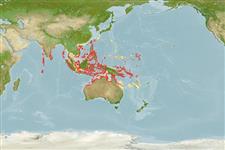Common names from other countries
Environment: milieu / climate zone / depth range / distribution range
Ecología
marino asociado a arrecife; no migratorio; rango de profundidad 5 - 30 m (Ref. 90102). Tropical; 25°N - 24°S, 72°E - 170°E
Indo-Pacific: Maldives to Vanuatu, north to the Yaeyama Islands; Palau and Krosae in Micronesia (Ref. 1602).
Tamaño / Peso / Age
Maturity: Lm ? range ? - ? cm
Max length : 38.0 cm TL macho / no sexado; (Ref. 9710)
Espinas dorsales (total) : 13 - 14; Radios blandos dorsales (total) : 16 - 18; Espinas anales: 3; Radios blandos anales: 16 - 18.
Found in coral rich areas of lagoons, channels, and outer reef slopes. Often near caves (Ref. 9710). Juveniles settle in very shallow inshore caves with algae growth (Ref. 48636). Usually solitary. Feeds on sponges and other encrusting organisms (Ref. 6113) and tunicates. Occasionally exported through the aquarium trade (Ref. 48391). Individuals under 20 cm in length are best adapted to tank life (Ref. 4907).
Life cycle and mating behavior
Maturities | Reproducción | Spawnings | Egg(s) | Fecundities | Larva
Myers, R.F., 1991. Micronesian reef fishes. Second Ed. Coral Graphics, Barrigada, Guam. 298 p. (Ref. 1602)
IUCN Red List Status (Ref. 130435)
CITES (Ref. 128078)
Not Evaluated
Threat to humans
Harmless
Human uses
Pesquerías: comercial; Acuario: Comercial
Herramientas
Special reports
Download XML
Fuentes de Internet
Estimates based on models
Preferred temperature (Ref.
115969): 25 - 29.3, mean 28.6 (based on 2337 cells).
Phylogenetic diversity index (Ref.
82804): PD
50 = 0.5001 [Uniqueness, from 0.5 = low to 2.0 = high].
Bayesian length-weight: a=0.03236 (0.01300 - 0.08052), b=2.89 (2.71 - 3.07), in cm Total Length, based on LWR estimates for this Genus-body shape (Ref.
93245).
Nivel trófico (Ref.
69278): 2.7 ±0.00 se; based on food items.
Resiliencia (Ref.
120179): Bajo, población duplicada en un tiempo mínimo de 4.5-14 años (Preliminary K or Fecundity.).
Fishing Vulnerability (Ref.
59153): Low to moderate vulnerability (28 of 100).
